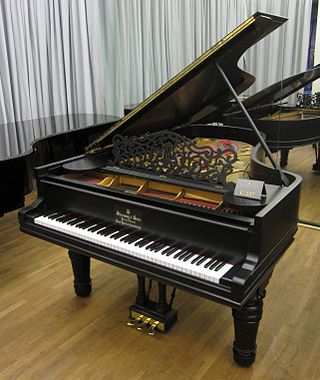
The piano is a keyboard instrument that produces sound when its keys are depressed, through engagement of an action whose hammers strike strings. Most pianos have a row of 88 black and white keys, representing each note of the chromatic scale as they repeat throughout the keyboard's span of seven and a quarter octaves. There are 52 white keys, known as “naturals”, and 36 black keys, known as “sharps”. The naturals repeat a pattern of whole steps and half steps unique to any given starting note. These patterns define a diatonic scale. The 36 sharps repeat a pattern of whole steps and minor thirds, which defines a pentatonic scale.

A digital piano is a type of electronic keyboard instrument designed to serve primarily as an alternative to the traditional acoustic piano, both in how it feels to play and in the sound it produces. Digital pianos use either synthesized emulation or recorded samples of an acoustic piano, which are played through one or more internal loudspeakers. They also incorporate weighted keys, which recreate the feel of an acoustic piano. Some digital pianos are designed to also look like an upright or grand piano. Others may be very simple, without a stand.

An electronic keyboard, portable keyboard, or digital keyboard is an electronic musical instrument based on keyboard instruments. Electronic keyboards include synthesizers, digital pianos, stage pianos, electronic organs and digital audio workstations. In technical terms, an electronic keyboard is a rompler-based synthesizer with a low-wattage power amplifier and small loudspeakers.

Novation Digital Music Systems Ltd. is a British musical equipment manufacturer, founded in 1992 by Ian Jannaway and Mark Thompson as Novation Electronic Music Systems. Today the company specializes in MIDI controllers with and without keyboards, both analog and virtual analog performance synthesizers, grid-based performance controllers, and audio interfaces. At present, Novation products are primarily manufactured in China.
Keytar is a keyboard instrument similar to a synthesizer or MIDI controller that is supported by a strap around the neck and shoulders, similar to the way a guitar is held.
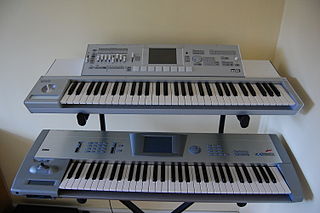
The Korg Triton is a music workstation synthesizer, featuring digital sampling and sequencing, released in 1999. It uses Korg's "HI Synthesis" system and was eventually available in several model variants with numerous upgrade options. The Triton became renowned as a benchmark of keyboard technology, and has been widely featured in music videos and live concerts. At the NAMM Show in 2007, Korg announced the Korg M3 as its successor.
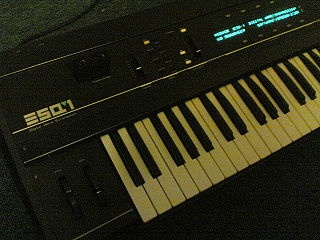
Ensoniq ESQ-1 is a 61-key, velocity sensitive, eight-note polyphonic and multitimbral synthesizer released by Ensoniq in 1985. It was marketed as a "digital wave synthesizer" but was an early Music Workstation. Although its voice generation is typically subtractive in much the same fashion as most analog synthesizers that preceded it, its oscillators are neither voltage nor "digitally controlled", but true digital oscillators, provided by a custom Ensoniq wavetable chip. The signal path includes analog resonant low-pass filters and an analog amplifier.
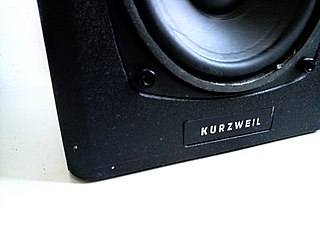
Kurzweil Music Systems is an American company that produces electronic musical instruments. It was founded in 1982 by Stevie Wonder (musician), Ray Kurzweil (innovator) and Bruce Cichowlas.

A MIDI controller is any hardware or software that generates and transmits Musical Instrument Digital Interface (MIDI) data to MIDI-enabled devices, typically to trigger sounds and control parameters of an electronic music performance. They most often use a musical keyboard to send data about the pitch of notes to play, although a MIDI controller may trigger lighting and other effects. A wind controller has a sensor that converts breath pressure to volume information and lip pressure to control pitch. Controllers for percussion and stringed instruments exist, as well as specialized and experimental devices. Some MIDI controllers are used in association with specific digital audio workstation software. The original MIDI specification has been extended to include a greater range of control features.
Keyboard expression is the ability of a keyboard musical instrument to change tone or other qualities of the sound in response to velocity, pressure or other variations in how the performer depresses the keys of the musical keyboard. Expression types include:

A stage piano is an electronic musical instrument designed for use in live performances on stage or in a studio, as well as for music recording in Jazz and popular music. While stage pianos share some of the same features as digital pianos designed for home use and synthesizers, they have a number of features which set them apart. Stage pianos usually provide a smaller number of sounds, with these being of higher quality than the ones found on regular digital pianos and home synthesizers.

A wind controller, sometimes referred to as a wind synthesizer, is an electronic wind instrument. It is usually a MIDI controller associated with one or more music synthesizers. Wind controllers are most commonly played and fingered like a woodwind instrument, usually the saxophone, with the next most common being brass fingering, particularly the trumpet. Models have been produced that play and finger like other acoustic instruments such as the recorder or the tin whistle. The most common form of wind controller uses electronic sensors to convert fingering, breath pressure, bite pressure, finger pressure, and other gesture or action information into control signals that affect musical sounds. The control signals or MIDI messages generated by the wind controller are used to control internal or external devices such as analog synthesizers or MIDI-compatible synthesizers, synth modules, softsynths, sequencers, or even non-instruments such as lighting systems.
The Nord Stage is a digital keyboard or stage piano, manufactured by Clavia Digital Music Instruments of Stockholm, Sweden. There have been six editions of the instrument: the original Nord Stage in 2005, the Nord Stage EX in 2008, the Nord Stage 2 in 2011, the Nord Stage 2 EX in 2015, the Nord Stage 3 in 2017, and the Nord Stage 4 in 2023.
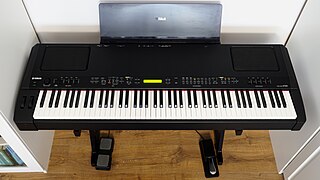
The Yamaha CP300 is a full-size digital stage piano with stereo speakers.
The AKAI MPK MINI is a hammer-action, 88-key MIDI controller keyboard released by Akai in November 2009. It is the only MIDI controller in the MPK series to feature hammer-weighted keys.

The Yamaha DX21 is a digital controlled bi-timbral programmable digital FM synthesizer with a four operator synth voice generator which was released in 1985. It uses sine wave-based frequency modulation (FM) synthesis. It has two FM tone generators and a 32-voice random-access memory (RAM), 32 user voices and 128 read-only memory (ROM) factory preset sounds. As a programmable synth, it enables users to create their own unique synthesized tones and sound effects by using the algorithms and oscillators. The instrument weighs 8 kg (17.6 lbs). On its release, it sold for $795.

The Seaboard is a musical keyboard-style MIDI controller manufactured by the British music technology company ROLI. It has a continuous sensor-embedded flexible rubber surface for playing the keys instead of traditional lever-style "moving keys". Some models, like the RISE Seaboard Grand, have an onboard sound engine. It has what the manufacturer calls "5D technology" which consists of five types of responsiveness to player actions: "strike", "glide" and "press", front to rear movement "slide" sensitivity, and release–velocity "lift". These responsiveness tools can be used to play the Seaboard with microtonal pitch bend sounds, by moving the finger from note to note, or trigger a vibrato effect into a string patch just by wiggling the finger, which would not be possible on a traditional MIDI controller using only the keys. The Seaboard also features polyphonic aftertouch, and a built-in USB- charged battery. There are three Seaboard models: the small minikey BLOCK, the RISE, and the GRAND, an 88-key keyboard with an onboard sound engine.

A digital accordion is an electronic musical instrument that uses the control features of a traditional accordion to trigger a digital sound module that produces synthesized or digitally sampled accordion sounds or, in most instruments, a range of non-accordion sounds, such as orchestral instruments, pipe organ, piano, guitar, and so on. Digital accordions typically encode and transmit key presses and other input as Musical Instrument Digital Interface (MIDI) messages. Most digital accordions need to be plugged into a keyboard amplifier or PA system to hear their sounds.
The 12 Step foot controller is a bass pedal-style programmable MIDI controller pedal keyboard made by Keith McMillen Instruments which was released in 2011. It has small, soft, rubbery keys that are played with the feet. As a MIDI controller, it does not make or output any musical sounds by itself; rather, it sends MIDI messages about which notes are played to an external synth module or computer music program running on a laptop or other computer. Each key on the 12 Step senses the velocity, aftertouch pressure, and the amount of tilt the player is applying with his feet. The messages from the player's foot presses can be sent via USB to a computer-based virtual instrument or to a synthesizer or other electronic or digital musical instrument.
The Nautilus is a music workstation manufactured by Korg, a successor to Kronos 2, which comes with Kronos' nine different synthesizer sound engines and other similar features. It was announced in November 2020 with availability in January 2021.






















